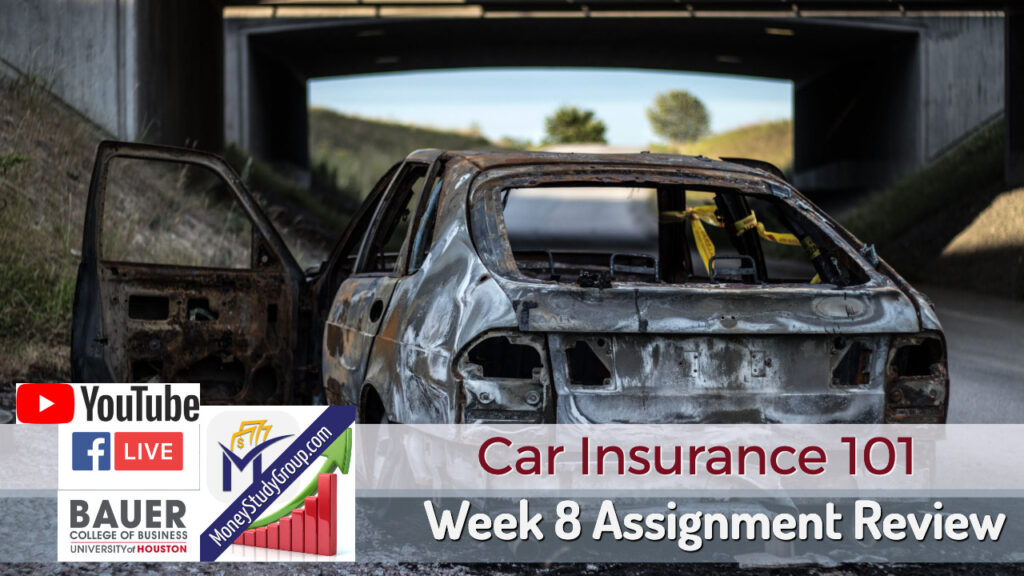-
Insurance 101 Assignment: Add Home and Auto Insurance to Your Plan

Insurance (Risk Management) is an essential element of Personal Finance. You’ll spend a lot of money buying insurance in your lifetime. So, a little insurance knowledge can help you Make Your Money Count.
This week, we’re focusing on Property and Casualty insurance. In this assignment, you will add insurance to your financial plan. The following information will help you understand Homeowners and Auto Insurance so that you can add the coverage you need to protect your investment (your new home and car).
Part One: Get Auto Insurance Quote
Obtain One Auto Insurance Quote online (or in a local insurance agency).
You can use your actual car, a family car, or a friend’s car to obtain the quote. Or, feel free to use the car you “pretended” to buy in your credit crush assignment for the auto quote.
Save the quote (PDF) along with your comments related to each coverage you selected – see below, Part Three.
Be sure to address the following coverages in your comments:
— Collision and Deductible (Earn 5 extra points by getting a quote for more than one deductible. How much will you save if you take a $1,000 deductible? Is it worth it? Or, how much more will you pay if you take a $250 deductible?)
— Comprehensive and Deductible
-
Consider getting a quote for more than one deductible.
-
How much will you save if you take a $1,000 deductible?
-
Is it worth it? Or,
-
How much more will you pay if you take a $250 deductible?)
— Liability 100/500/100 (address each of these three numbers and what they mean)
— Rental
— Emergency Road Service
— Personal Injury Protection 2500/5000/10000
— Medical Payments Coverage 2500/5000/10000
If you’re employed, you will want PIP (Personal Injury Protection); if you’re unemployed, you will want MPC (Medical Payments Coverage).
— Uninsured
— Underinsured
Also discuss any other coverage offered by the agent you meet with or talk to online. In order to receive full credit for this assignment, you will need to convince me that you understand each of the coverages listed above.
— What is a deductible? How does it work? Explain that, too.
Part Two: Add Auto and Homeowners Insurance to Your Plan
Save a Screenshot for each Insurance Policy Added to Your Plan
Homeowners Insurance Coverage Summary
Section I Coverages: Property
-
Coverage A: Dwelling
-
Coverage B: Other structures
-
Coverage C: Personal property
-
Coverage D: Loss of use
-
Section II Coverages:
-
Coverage E: Personal Liability
-
Coverage F: Medical Payments to Others
Coverage A: Dwelling
-
Covers repair or replacement of the house, attached structures and building materials on premises.
-
Purchase an amount equal to replacement cost (cost to rebuild) of the building.
-
Insured must carry at least 80% of replacement cost of the building (coinsurance). See Coinsurance
Actual Cash Value (ACV)
Represents depreciated value of the property.
Replacement Cost (RC)
-
Amount necessary to purchase, repair or replace with similar quality at current prices
-
Insured must carry 80% of the replacement cost at the time of the loss
Coverage B: Other Structures
-
Includes detached garages, storage buildings, etc.
-
Limit is usually 10% of the amount of Coverage A.
-
Other structures will not be covered if used for business purposes.
Coverage C: Personal Property
-
Includes furniture, electronics, clothing, paintings, etc.
-
Standard coverage is for actual cash value.
-
Limits are placed on certain personal property losses, e.g. cash, coin collections ($200), jewelry ($1,500).
-
Limit is usually 50% of Coverage A, but be sure to read the policy.
-
Coverage is effective regardless where you property is located.
-
Need an endorsement for personal property to have replacement cost rather than actual cash value. If you have a loss you want a new TV, not the depreciated value of your TV.
-
Need a rider for high value jewelry because of low policy limits.
Coverage C: Personal Property specifically excluded:
-
Animals, birds, and fish
-
Articles separately described and specifically insured
-
Motorized land vehicles used off premises
-
Property of roomers or boarders not related to the insured
-
Aircraft and parts
-
Furnishings on property rented out to others
-
Property held as samples, held for sale, or sold but not delivered
-
Business data, credit cards, and funds transfer cards
-
Business property held away from the residence premises
Coverage D: Loss of Use
-
A combination of additional living expenses and loss of rental income.
-
The limit is usually 30% of the Coverage A amount.
-
The loss resulting from living in a hotel because residence is damaged or being repaired.
-
This section only applies to additional living expenses.
-
Alternatively, if rental income is lost due to a property being damaged, the insured may collect loss of use.
Section II Coverages: Liability
Coverage E: Personal Liability
-
Protects the insured against claims arising out of both bodily injury and property damage.
-
The insurer will cover both the damages and the costs of any defense of the claim or suit.
-
The minimum amount of coverage is $100,000 per occurrence.
-
The Coverage E liability insurance is based on a legal liability to pay.
-
The insurer will only pay to the lesser of the damage or the coverage.
-
This section excludes professional liability exposures.
Coverage F: Medical Payments to Others
-
Includes coverage for the medical payments to others for injuries that arise even where the insured is not liable for the injury.
-
Medical expenses include reasonable charges for medical procedures, surgical procedures, hospital stays, ambulances, dental care, X-rays, professional nursing, prosthetic devices, and funeral services.
-
It does not apply to the insured or members of the insured’s household.
-
This coverage is not liability insurance coverage and is not based on fault.
One of the following conditions must be met for an individual to receive medical payments coverage:
-
The injury occurs while the person has permission to be at the insured location.
-
The injury occurs while the person is away from the insured location and is caused by a condition at the insured location or on property immediately adjoining the insured location.
-
For example, ice on the sidewalk or driveway and someone slips and falls
-
The insured injures another person while away from the insured location.
-
An animal owned by or in the care of the insured injures an individual off the insured premises.
Medical Payments will not provide coverage for bodily injuries:
-
Sustained by the insured or any family member.
-
Sustained by a regular resident of an insured location.
-
Sustained by a residence employee of the insured that occur outside of the scope of employment.
-
Sustained by anyone eligible to receive benefits for their injuries under a workers compensation or similar disability law.
-
Resulting from nuclear reaction radiation, etc., regardless of how cause.
Part Three: Submit one PDF Document (Article)
Include the following in your article
A Brief Summary
-
How Much Coverage did you add for your Home?
-
How did you determine this amount?
-
What Auto Coverages did you select for your Auto Insurance Quote:
-
-
Briefly summarize each coverage you selected and why
-
Include a screenshot of this week’s quiz
-
Submit one PDF Document for this Assignment
-
Include the Auto Quote (or sreenshots)
-
Include Screenshots for the insurance you added to your financial plan
-
Include your Brief Summary as outlined above
Availability:
Item is hidden from students. It was last available on Apr 30, 2021 11:59 PM.
Week 8 Insurance 101
-





